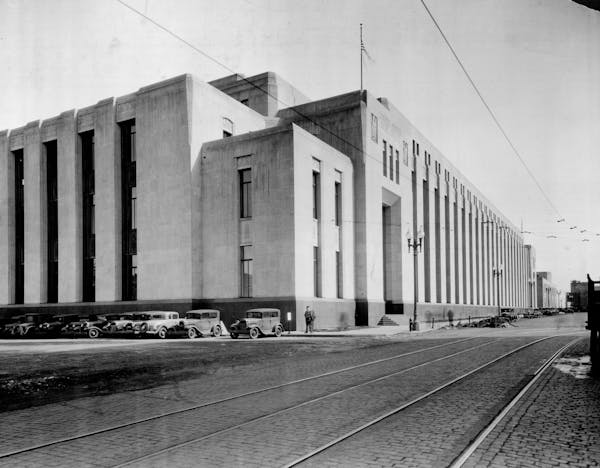There's an old joke that the Puritans wanted to ban sex because they feared it might lead to dancing. The Puritans, God bless them, didn't have much luck outlawing sex, but dancing was long a problem for those concerned about preserving public decency, however that might be defined.
The uproar over a long-forgotten downtown dance hall in Minneapolis directly across from City Hall provides a window into just how readily a two-step or two could fluster local guardians of morality.
The Dreamland Dancing Pavilion opened late in 1909, complete with a Renaissance-inspired facade sporting pedimented windows and an arched entryway flanked by paired Corinthian columns. But the real business of the building, as designed by Minneapolis society architect William Channing Whitney, was the ballroom at the rear, its broad expanse set beneath arched steel trusses.
Big downtown dance halls have long since vanished from the Twin Cities, but they were once extremely popular here and nationwide. Dreamland was one of a chain of halls built around the same time in cities that included Cleveland, St. Louis, Seattle and San Francisco.
In its first full year of operation, Dreamland claimed to have attracted 780,000 customers, at a time when the population of Minneapolis barely exceeded 300,000. As constructed, it was the largest dance hall in the city, although by 1915 it would face stiff competition from the new Majestic (later Marigold) Ballroom at 1336 Nicollet Av.
When Dreamland made its debut, the Tribune wrote, "This new palace of entertainment is a treat to the eye with its myriad of colored lights and handsome Oriental decorations and a glance at the interior cannot fail to bring forth an exclamation of delight."
But it wasn't long before less delightful exclamations began emanating from city officials, police and local religious leaders. From their viewpoint, Dreamland was a den of iniquity where underaged dancers all too often frolicked and prostitutes cruised the crowd in search of customers.
These concerns peaked in 1911 and early 1912, when Minneapolis officials were trying to close down the last of the city's once numerous brothels. With sex clearly on the municipal mind, Dreamland's manager was hauled into court several times on charges of allowing minor girls into the establishment and thereby, it was claimed, propelling them down the road to perdition.
The court cases naturally attracted plenty of attention from the Tribune and other local newspapers. The stories are amusing to read today because the writers, in keeping with the straitlaced journalistic standards of the time, had to trot out all manner of circumlocutions and euphemisms to describe what was supposedly going on at the dance hall.
So it was that stories warned of the "baleful influence" of women "of questionable morals" or "the lowest character" who allegedly frequented Dreamland. One article told of a man sentenced to 60 days in the county workhouse "after admitting that he had lived for six months on the earnings" of one of Dreamland's habitués, who was duly identified as "an inmate of a St. Paul resort." (Translation: The man was found guilty of being a pimp, since in 1912 newspaper parlance an urban "resort" was most definitely not a place for a family vacation.)
Religious leaders fulminated against Dreamland, stating that young women were at grave risk of moral decay once they passed through its doors. The Minneapolis Society for the Prevention of Cruelty to Children and Animals (yes, its original purview was not limited to the four-legged) also took a dim view of Dreamland and its ilk, and agitated for stricter regulation.
Among the ministers condemning Dreamland was a Lutheran pastor who claimed that several 16-year-old girls from his church had made the mistake of going to the dance hall and "are now walking the streets of Minneapolis at night."
Yet not every public official saw Dreamland as an outpost of Satan. Minneapolis School Superintendent C.M. Jordan, for example, reported that he went to Dreamland one night and "saw nothing there that could not have happened properly in one's sitting room."
A big part of the problem facing Dreamland and similar establishments was a state law that barred anyone under age 21 from public dances. J.M. Wood, Dreamland's owner, pointed out how absurd the law was, given that 18-year-olds could marry in Minnesota. He went on to note that because of the law, Dreamland's local manager couldn't even allow his 20-year-old wife to attend dances there.
The hullabaloo over dance halls died down fairly quickly, though. And little note was made in the press when new owners took over Dreamland in 1915 and renamed it the Arcadia Dance Palace. It operated under that name until 1934, when it briefly became the Aragon before closing for good in 1935.
The old dance hall was then refitted into a parking garage. Known initially as the Courthouse Garage, it remained in operation through the 1950s. The building was finally torn down in 1961, its days of waltzes, foxtrots and controversy already long gone. The Hennepin County Government Center now occupies the site, and if any dancing goes on there, I haven't seen it.
Mexican film wins top prize at Moscow International Film Festival while major studios boycott Russia
Why you might have heard Paul Simon's 'The Sound of Silence' at Spanish Mass

Minneapolis native Poppy Harlow parts ways with CNN



